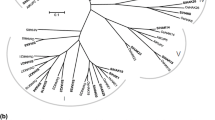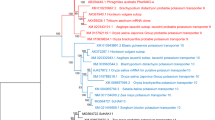Abstract
High-affinity K+ uptake in plants plays a crucial role in K+ nutrition and different systems have been postulated to contribute to the high-affinity K+ uptake. The results presented here with pepper (Capsicum annum) demonstrate that a HAK1-type transporter greatly contributes to the high-affinity K+ uptake observed in roots. Pepper plants starved of K+ for 3 d showed high-affinity K+ uptake (K m of 6 μM K+) that was very sensitive to NH and their roots expressed a high-affinity K+ transporter, CaHAK1, which clusters in group I of the KT/HAK/KUP family of transporters. When expressed in yeast (Saccharomyces cerevisiae), CaHAK1 mediated high-affinity K+ and Rb+ uptake with K m values of 3.3 and 1.9 μ M, respectively. Rb+ uptake was competitively inhibited by micromolar concentrations of NH and Cs+, and by millimolar concentrations of Na+.
Similar content being viewed by others
References
Ahn, S. J., Shin, R. and Schachtman, D. P. 2004. Expression ofKT/KUP genes in Arabidopsis and the role of root hairs inK+ uptake. Plant. Physiol. 134: 1135–1145.
Anderson, J. A., Huprikar, S. S., Kochian, L. V., Lucas, W. J. and Gaber, R. F. 1992. Functional expression of a probableArabidopsis thaliana potassium channel in Saccharomycescerevisiae. Proc. Natl. Acad. Sci. USA 89: 3736–3740.
Armengaud, P., Breitling, R. and Amtmann, A. 2004. Thepotassium-dependent transcriptome of Arabidopsis reveals aprominent role of jasmonic acid in nutrient signaling. PlantPhysiol. (Epub ahead of print)
Banuelos, M. A., Garciadeblas, B., Cubero, B. and Rodriguez-Navarro, A. 2002. Inventory and functional characterizationof the HAK potassium transporters of rice. Plant Physiol. 130: 784–795.
Brunelli, J. P. and Pall, M. L. 1993. A series of yeast shuttlevectors for expression of cDNAs and other DNA-sequences. Yeast 9: 1299–1308.
Epstein, E. 1973. Mechanisms of ion transport through plantcell membranes. Int. Rev. Cytol. 34: 123–168.
Flowers, T. J. and La¨uchli, A. 1983. Sodium versus potassium: substitution and compartmentation. In: A. La¨uchli, R. L. Bieleski, (Eds. ), Inorganic Plant Nutrition, Vol. 15B. Springer-Verlag, Berlin, pp. 651–681.
Gerendas, J., Zhu, Z. J., Bendixen, R., Ratcliffe, R. G. and Sattelmacher, B. 1997. Physiological and biochemical processesrelated to ammonium toxicity in higher plants. ZPflanz. Bodenkunde 160: 239–251.
Glass, A. 1975. The regulation of potassium absorption inbarley roots. Plant Physiol. 56: 377–380.
Greenway, H. and Munns, R. 1980. Mechanism of salttolerance in nonhalophytes. Annu. Rev. Plant Physiol. 31: 149–190.
Haro, R., Sainz, L., Rubio, F. and Rodriguez-Navarro, A. 1999. Cloning of two genes encoding potassium transportersin Neurospora crassa and expression of the correspongingcDNAs in Saccharomyces cerevisiae. Mol. Microbiol. 31: 511–520.
Hirsch, R. E., Lewis, B. D., Spalding, E. P. and Sussman, M. R. 1998. A role for the AKT1 potassium channel in plant nutrition. Science 280: 918–21.
Kaya, C. and Higgs, D. 2003. Supplementary potassium nitrateimproves salt tolerance in bell pepper plants. J. Plant Nutr. 26: 1367–1382.
Kaya, C., Higgs, D., Ince, F., Amador, B. M., Cakir, A. and Sakar, E. 2003. Ameliorative effects of potassium phosphateon salt-stressed pepper and cucumber. J. Plant Nutr. 26: 807–820.
Maas, E. V., Hoffman, G. J. 1977. Crop salt tolerance-currentassessment. J. Irrig. Drainage Div. 103: 115–134.
Maathuis, F. J. M. and Sanders, D. 1992. Plant membranetransport. Curr. Opin. Cell Biol. 4: 661–669.
Marini, A. M., SoussiBoudekou, S., Vissers, S. and Andre, B. 1997. A family of ammonium transporters in Saccharomycescerevisiae. Mol. Cell. Biol. 17: 4282–4293.
Maser, P., Thomine, S., Schroeder, J. I., Ward, J. M., Hirschi, K., Sze, H., Talke, I. N., Amtmann, A., Maathuis, F. J., Sanders, D., Harper, J. F., Tchieu, J., Gribskov, M., Persans, M. W., Salt, D. E., Kim, S. A. and Guerinot, M. L. 2001. Phylogenetic relationships within cation transporterfamilies of Arabidopsis. Plant Physiol. 126: 1646–1667.
Rodriguez-Navarro, A. and Ramos, J. 1984. Dual system forpotassium transport in Saccharomyces cerevisiae. J. Bacteriol. 159: 940–945.
Rodr?´guez-Navarro, A. 2000. Potassium transport in fungi and plants. Biochim. Biophys. Acta 1469: 1–30.
Rubio, F., Gassmann, W. and Schroeder, J. I. 1995. Sodium driven potassium uptake by the plant potassium transporterHKT1 and mutations conferring salt tolerance. Science 270: 1660–1663.
Rubio, F., Santa-Maria, G. E. and Rodr?´guez-Navarro, A. 2000. Cloning of Arabidopsis and barley cDNAs encodingHAK potassium transporters in root and shoot cells. Physiol. Plant. 109: 34–43.
Rubio, F., Schwarz, M., Gassmann, W. and Schroeder, J. I. 1999. Genetic selection of mutations in the high affinity K+transporter HKT1 that define functions of a loop site forreduced Na+ permeability and increased Na+ tolerance. J. Biol. Chem. 274: 6839–6847.
Sambrook, J., Fritsch, E. F. and Maniatis, T. 1989. MolecularCloning: A laboratory Manual. Cold Spring Harbor LaboratoryPress, Cold Spring Harbor, NY.
Santa-Mar?´a, G. E., Danna, C. H. and Czibener, C. 2000. High affinity potassium transport in barley roots. Ammoniumsensitive and-insensitive pathways. Plant Physiol. 123: 297–306.
Santa-Mar?´a, G. E., Rubio, F., Dubcovsky, J. and Rodriguez-Navarro, A. 1997. The HAK1 gene of barley is a member ofa large gene family and encodes a high-affinity potassiumtransporter. Plant Cell 9: 2281–2289.
Searle, P. L. 1984. The Berthelot or indophenol reaction and its use in the analytical chemistry of nitrogen. A review. Analyst109: 549–568.
Sentenac, H., Bonneaud, N., Minet, M., Lacroute, F., Salmon, J. M., Gaymard, F. and Grignon, C. 1992. Cloning and expression in yeast of a plant potassium ion transport system. Science 256: 663–665.
Sherman, F. 1991. Getting started with yeast. Methods Enzymol. 194: 3–21.
Shin, R. and Schachtman, D. P. 2004. Hydrogen peroxide mediates plant root cell response to nutrient deprivation. Proc. Natl. Acad. Sci. USA 101: 8827–8832.
Spalding, E. P., Hirsch, R. E., Lewis, D. R., Qi, Z., Sussman, M. R. and Lewis, B. D. 1999. Potassium uptake supportingplant growth in the absence of AKT1 channel activity: inhibition by ammonium and stimulation by sodium. J. Gen. Physiol. 113: 909–18.
Thompson, J. D., Gibson, T. J., Plewniak, F., Jeanmougin, F. and Higgins, D. G. 1997. The CLUSTAL_X windows interface: flexible strategies for multiple sequence alignment aided by quality analysis tools. Nucleic Acids Res. 25: 4876–4882.
Very, A. A. and Sentenac, H. 2003. Molecular mechanisms andregulation of K+ transport in higher plants. Ann. Rev. PlantBiol. 54: 575–603.
Walker, D. J., Leigh, R. A. and Miller, A. J. 1996. Potassiumhomeostasis in vacuolate plant cells. Proc. Natl. Acad. Sci. USA 93: 10510–10514.
Wang, Y. H., Garvin, D. F. and Kochian, L. V. 2002. Rapidinduction of regulatory and transporter genes in response tophosphorus, potassium, and iron deficiencies in tomatoroots. Evidence for cross talk and root/rhizosphere-mediatedsignals. Plant Physiol. 130: 1361–1370.
Xu, G. H., Wolf, S. and Kafkafi, U. 2002. Ammonium onpotassium interaction in sweet pepper. J. Plant Nutr. 25: 719–734.
Author information
Authors and Affiliations
Rights and permissions
About this article
Cite this article
Martínez-Cordero, M.A., Martínez, V. & Rubio, F. Cloning and functional characterization of the high-affinity K+ transporter HAK1 of pepper. Plant Mol Biol 56, 413–421 (2004). https://doi.org/10.1007/s11103-004-3845-4
Issue Date:
DOI: https://doi.org/10.1007/s11103-004-3845-4




